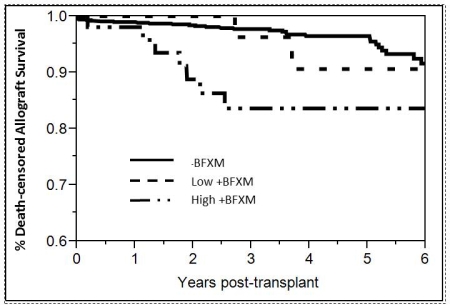Outcomes Following Kidney Transplant With Low Level Positive Flow Cytometric Crossmatch
Mayo Clinic, Rochester, MN.
Meeting: 2015 American Transplant Congress
Abstract number: A90
Keywords: Antibodies, Kidney transplantation, Rejection
Session Information
Session Name: Poster Session A: Kidney Antibody Mediated Rejection
Session Type: Poster Session
Date: Saturday, May 2, 2015
Session Time: 5:30pm-7:30pm
 Presentation Time: 5:30pm-7:30pm
Presentation Time: 5:30pm-7:30pm
Location: Exhibit Hall E
Introduction: Highly-sensitized kidney transplant (KTx) candidates have difficulty finding a negative crossmatch donor. KTx with low level positive crossmatch might be the next best option. Data supporting this approach is lacking. We compared outcomes of KTx with a negative B flow cytometric crossmatch (BFXM) to those with low and high BFXM.
Methods: First time solitary KTx from 10/2007 and 5/2014 were divided into 3 groups: -BFXM, low flow +BFXM (channel shift 106-199), and high flow + BFXM (channel shift 200-450). Mean follow-up was 3.3 years (3 months to 7 years). Protocol biopsies were performed at 1 and 2 years post-transplant.
Results: 994 KTx were performed: 883 – BFXM, 58 low flow +BFXM, and 53 high +BFXM. In the high +BFXM group 58.6% were treated with eculizumab, PE+ IVIG pre-transplant, and 6.7% received PE+IVIG only. No other patients received desensitization. Death-censored allograft survival was higher in the – BFXM and low + BFXM groups (both, 96.4%) than the high +BFXM group (86.8%, p=0.003).  Early acute clinical AMR occurred in 0.8% (7/883) of -BFXM, 5.2% (3/58) of low + BFXM, and 13.2% (7/53) of high + BFXM group, p=0.001. Transplant glomerulopathy (TG, Banff cg score > 0) was present at 1 year in 2.2% (16/725) of -BFXM, 10.4% (5/48) of low + BFXM, and 22.2% (10/45) of high +BFXM, p<0.0001. At 2 years, TG was present in 4.7% (21/446), 20.0% (7/35), and 23.5% (8/34) in these groups respectively, p<0.0001. At 2 years, mean creatinine and proteinuria was similar among groups. The mean creatinine (mg/dl) was 1.5 in -BFXM group, 1.3 low + BFXM group, and 1.6 in the high +BFXM group. The mean 24-hr urine protein (mg) was 198.0 in -BFXM group, 225.4 low + BFXM group, and 263.0 in the high +BFXM group.
Early acute clinical AMR occurred in 0.8% (7/883) of -BFXM, 5.2% (3/58) of low + BFXM, and 13.2% (7/53) of high + BFXM group, p=0.001. Transplant glomerulopathy (TG, Banff cg score > 0) was present at 1 year in 2.2% (16/725) of -BFXM, 10.4% (5/48) of low + BFXM, and 22.2% (10/45) of high +BFXM, p<0.0001. At 2 years, TG was present in 4.7% (21/446), 20.0% (7/35), and 23.5% (8/34) in these groups respectively, p<0.0001. At 2 years, mean creatinine and proteinuria was similar among groups. The mean creatinine (mg/dl) was 1.5 in -BFXM group, 1.3 low + BFXM group, and 1.6 in the high +BFXM group. The mean 24-hr urine protein (mg) was 198.0 in -BFXM group, 225.4 low + BFXM group, and 263.0 in the high +BFXM group.
Conclusion: Compared to – BFXM, low + BFXM kidney transplants have a higher rate of early acute clinical AMR but similar graft survival (mean follow-up of 3.3 yrs). TG increased in all groups over time, but renal function was stable for most up to 5 years. A low +BFXM appears to be a reasonable option for select highly-sensitized renal transplant recipients and should be preferred over higher BFXM options.
To cite this abstract in AMA style:
Schinstock C, Cosio F, Gandhi M, Cornell L, Stegall M. Outcomes Following Kidney Transplant With Low Level Positive Flow Cytometric Crossmatch [abstract]. Am J Transplant. 2015; 15 (suppl 3). https://atcmeetingabstracts.com/abstract/outcomes-following-kidney-transplant-with-low-level-positive-flow-cytometric-crossmatch/. Accessed December 20, 2025.« Back to 2015 American Transplant Congress
